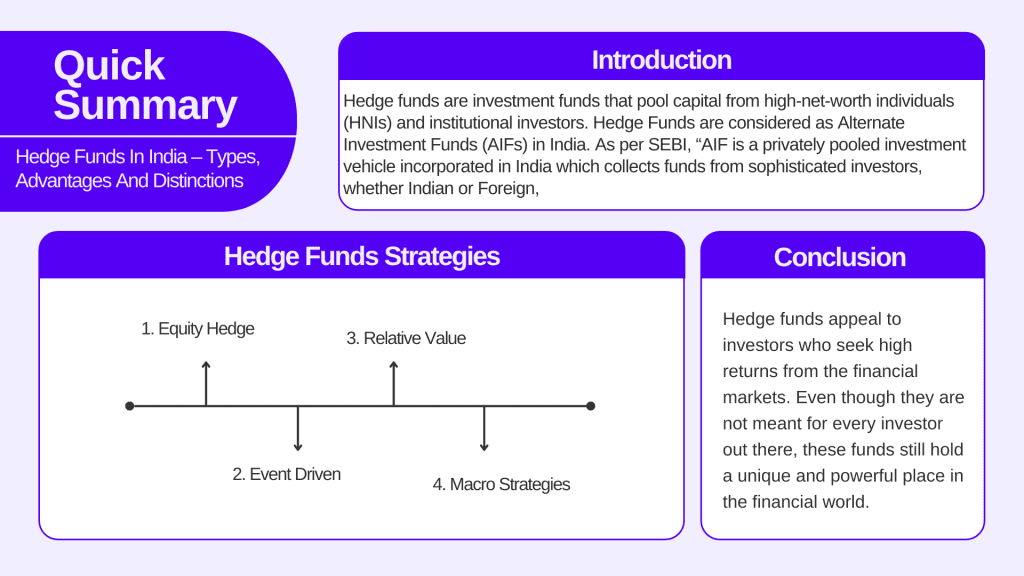| Type | Description | Contributor | Date |
|---|---|---|---|
| Post created | Pocketful Team | Dec-20-23 | |
| Add new links | Nisha | Feb-19-25 |

- Blog
- decoding hedge funds in india types advantages and distinctions
Decoding Hedge Funds In India – Types, Advantages And Distinctions


Hedge Funds are attractive, yet often misunderstood financial products. In our today’s blog, we will learn about these funds and understand what place they hold in the investment landscape.
What are Hedge Funds?
Hedge funds are investment funds that pool capital from high-net-worth individuals (HNIs) and institutional investors.
These funds are managed by professional fund managers and deploy capital in complex products and strategies like listed and unlisted derivatives, real estate, convertible debt, etc. They have the potential to deliver significant returns but also carry significant risks.
They play a significant role in portfolio diversification since they help in diversifying the portfolio and provide a chance to invest in complex strategies.

Hedge Funds in India
Hedge Funds are considered as Alternate Investment Funds (AIFs) in India. As per SEBI, “AIF is a privately pooled investment vehicle incorporated in India which collects funds from sophisticated investors, whether Indian or Foreign, for investing it in accordance with a defined investment policy for the benefit of its investors”.
There are three categories of AIFs classified by SEBI:
1. Category I AIF: Venture Capital Funds, Angel Fund, etc.
2. Category II AIF: Funds that do not fall in Category I and Category III.
3. Category III AIF: Hedge Funds
Hedge funds fall in Category 3 AIFs. These funds are not pass-through entities and are taxed at the fund level. In other words, tax will be paid by the fund, and investors are not required to pay tax. However, this is generally less tax efficient as compared to other investment options.
As per SEBI, there are 1,220 Alternative Investment Funds registered in India as of December 2023.
Features of Hedge Funds
1. Hedge Funds can be registered as a trust, company, or LLP. Generally, partnership structure consists of General Partners and Limited Partners.
- General Partners (GPs): GPs actively manage the operations of the fund and also invest in it. They have unlimited liability.
- Limited Partners (LPs): LPs are the investors that do not take participation in the management. Further, they have a limited liability.
2. Hedge funds employ a plethora of strategies, including long and short positions, arbitrage, derivatives trading, etc. although they are flexible and can also invest in equity, currency, and commodities.
3. Hedge funds try to generate alpha over benchmark returns, i.e., the main objective of hedge funds is to generate positive returns irrespective of the market conditions.
4. Hedge funds carry high charges & fees. These funds charge both management fees and a share of the investor’s profit.
5. Hedge Funds are generally targeted to sophisticated investors, i.e., HNIs, Institutional Investors, Family offices, etc. as the minimum investment amount is in crores. As per SEBI, the minimum amount to start investing in a Hedge fund is one crore, and the entire fund should have a corpus of at least INR 20 crs.
6. Hedge Funds are less regulated as and when compared to mutual funds. Periodic disclosures of NAVs of hedge funds to SEBI are not mandatory. Further, there is no requirement for these funds to register with the Securities and Exchange Board of India (SEBI).
7. Hedge funds have low liquidity, and investors may need to face lock-in periods. They can be open-ended or close-ended.
Hedge Funds Strategies:
Hedge Funds are generally classified by strategies. Such strategies change over time when new strategies are introduced in the market. There are four broader hedge fund strategies:
1. Equity Hedge – They focus on equity and equity related instruments. These funds focus on both long and short positions. Equity Hedge includes strategies such as Market Neutral, Fundamental Value, Sector specific, etc.
2. Event Driven – Event Driven strategies focus on generating profits from certain corporate actions. These include strategies like Merger Arbitrage, Special Situations, etc.
2. Relative Value – These funds capitalise on pricing differences in the market and try to generate profits from relative price movements. These include Volatility trading, Multi Strategy, Fixed Income, etc.
4. Macro Strategies: These funds follow a top-down approach to identify various macro events such as economic activities, interest rates, fluctuation in currencies, etc.
There are also Fund of Hedge Funds (FoHF), which are similar to Fund of Funds (FoF). These funds invest in a diversified portfolio of multiple hedge funds.
Fee Structure of Hedge Funds
Here is a breakdown of the fee structure:
1. Management Fees
Management fees range from 1-2% and are charged irrespective of the fund’s performance.
2. Performance Fees
Performance fees are a percentage of the fund’s profit and are generally around 20%
3. Hurdle Rate
It is a pre-decided minimum level of return that the fund needs to achieve before the performance fee is charged. It can be of multiple types: Soft hurdle, Hard hurdle, or Blended Hurdle.
Apart from these, hedge funds may charge transaction costs from investors. The above-mentioned fee structure can change depending on the type of hedge fund. It is suggested for the investors to carefully review and analyse the fee structure before investing.
Read Also: A Comprehensive Guide on Mutual Fund Analysis
Difference between Mutual Funds and Hedge Funds
- Investors with low capital can also invest in mutual funds, whereas investments in hedge funds are allowed only for HNI and institutional investors as the minimum investment amount is in crores.
- Mutual funds are subject to stricter regulations and disclosure requirements about investments as compared to hedge funds. Hedge funds are less regulated and riskier than mutual funds.
- Mutual fund is suitable for investors who seek long-term growth and lesser risk and hedge funds are meant for investors who have a high-risk appetite.
- Mutual funds do not charge any fees on profits earned by investors whereas, in the case of hedge funds, fund managers can ask for a share in the profits of the investors.
Benefits of Investing in Hedge Funds

- Diversification: Hedge funds allow diversification that can reduce the overall risk of the portfolio. Hedge fund returns may not move in sync with stock or bond markets, potentially offering greater diversification and stability.
- Returns: Hedge funds aim to generate good returns irrespective of the prevailing trends in the market.
- Professionally Managed: They are professionally managed. Fund managers earn performance fees from the investors. This encourages them to strive for strong and better performance.
Demerits of Investing in Hedge Funds:
1. Not transparent: Hedge Funds operate in a less regulated world and are not obliged to issue performance reports, portfolio holdings, etc. Further, they are not allowed to advertise in India.
2. Not for all: As discussed above, hedge funds deploy capital in complex strategies and carry higher risk as compared to other investment options. Further, the minimum investment amount is generally in crores, whereas in other investment options like Mutual funds, you can invest from as low as INR 100.
3. Expensive: Hedge Funds are substantially more expensive than traditional investments and may not be tax efficient as compared to other investment options.
Read Also: Decoding Credit Risk Funds In India
Conclusion
On a parting note, hedge funds appeal to investors who seek high returns from the financial markets. Even though they are not meant for every investor out there, these funds still hold a unique and powerful place in the financial world. Understanding their strengths, weaknesses, and proper due diligence is important for investors before considering them as an investment option.
Frequently Asked Questions (FAQs)
Can hedge funds advertise in India?
No, as per SEBI, AIFs are privately pooled investments that raise funds via private placement only.
Hedge Funds fall under which category of AIF
Hedge funds are Category III AIF.
What is the most common fee structure charged by hedge funds?
Most Hedge Funds follow 2 / 20 structure means a 2% management fee and 20% performance fee.
Is NAV disclosure mandatory for hedge funds?
No, NAV disclosure is not mandatory for hedge funds.
Are Hedge funds more regulated than mutual funds?
No, hedge funds are comparatively less regulated than mutual funds.
Disclaimer
The securities, funds, and strategies discussed in this blog are provided for informational purposes only. They do not represent endorsements or recommendations. Investors should conduct their own research and seek professional advice before making any investment decisions.